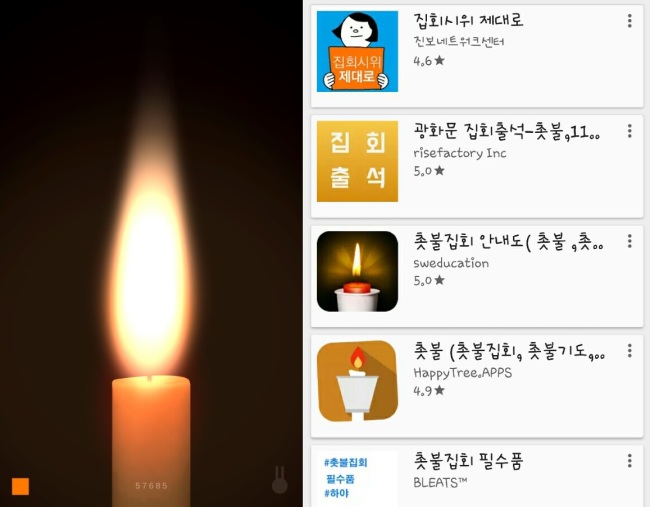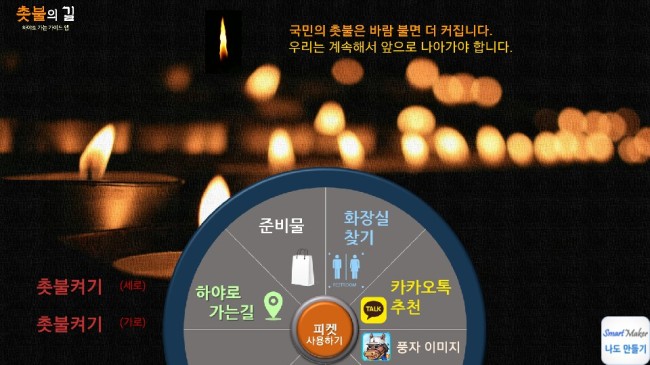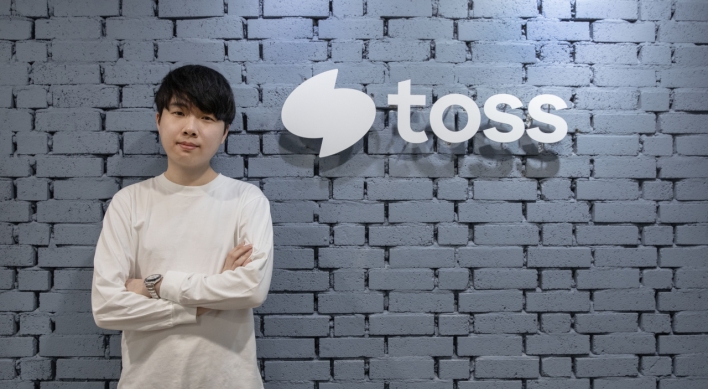Behind rallies, mobile apps support Seoul protesters
By Sohn Ji-youngPublished : Nov. 27, 2016 - 15:58
Merging technology with social activism, South Korean developers have rolled out a series of new mobile apps to support citizens who are taking to the streets of Seoul to demand President Park Geun-hye’s resignation.
As the weekly demonstrations continue to widen, multiple mobile apps designed for easy use by rally participants have appeared on the Google Play and Apple app stores.
Apps that display a virtual candlelight on a smartphone screen are by far the most widely downloaded app among local rally participants, especially those who were unable to purchase a physical candle or were worried that real candles may catch fire or be blown out by the wind.
As the weekly demonstrations continue to widen, multiple mobile apps designed for easy use by rally participants have appeared on the Google Play and Apple app stores.
Apps that display a virtual candlelight on a smartphone screen are by far the most widely downloaded app among local rally participants, especially those who were unable to purchase a physical candle or were worried that real candles may catch fire or be blown out by the wind.

For instance, one app called "Soonsoon Candlelight" displays a burning candle which sways along with the movement of a user’s smartphone. Users can change the size of the flame and its color, as well as add a message to the top of the candle.
“There are some candles in the world that never go out even when the wind blows,” the app’s developer Soonsoon wrote on the app’s introductory section on Google Play.
In addition to its literal meaning, the statement also stands in protest against a former remark by Rep. Kim Jin-tae of the ruling Saenuri Party that public anger will die down over time.
“Candlelight is just candlelight. It is bound to be blown out by the wind. Public sentiment can change any time,” Kim said during a National Assembly meeting on Nov. 17.

Other useful apps include "Candlelit Path," which offers directions to the subway exits that lead to Gwanghwamun Square, a list of useful items to bring to the rally as well as the location of public restrooms in the area.
“I decided to create this app to resolve some of the common inconveniences experienced by citizen protestors,” Kim Gun-joon, university student and the developer of “Candlelit Path,” told The Korea Herald.
“For instance, I noticed that some people who aren’t familiar with the Gwanghwamun area had trouble finding public restrooms,” said Kim, who has been participating in the protests since week one.
Another stand-out app is the Gwanghwamun Rally Attendance App, which allows users who arrive at the rally site to “check-in” on the app to report their attendance, age and gender. The app links to a smartphone’s GPS to determine whether he or she is physically present at the site.
The app aims to “come up with a more accurate head count of the rally’s participants” after the police estimate of the turnout was found to be much lower than that claimed by the protest organizers.
Meanwhile, a free mobile chatting app that lets users in close proximity communicate freely without an internet connection or mobile network, has also risen to the spotlight in the wake of poor mobile network connectivity at the Seoul rally site.
FireChat is a peer-to-peer “mesh networking service” that does not require an active network connection. It uses a mobile phone’s built-in Bluetooth and Wi-Fi to enable devices to directly communicate with each other.
In the past, Taiwanese students used FireChat to communicate among themselves without government interference during the anti-Beijing Sunflower Student Movement in 2014.
Youths in Iraq and Iran have also used the app to communicate when the government blocked public internet access to prevent uprisings.
By Sohn Ji-young (jys@heraldcorp.com)
Intern reporter Song Ji-won contributed to this article. --Ed.


![[AtoZ into Korean mind] Humor in Korea: Navigating the line between what's funny and not](http://res.heraldm.com/phpwas/restmb_idxmake.php?idx=644&simg=/content/image/2024/04/22/20240422050642_0.jpg&u=)


![[Herald Interview] Why Toss invited hackers to penetrate its system](http://res.heraldm.com/phpwas/restmb_idxmake.php?idx=644&simg=/content/image/2024/04/22/20240422050569_0.jpg&u=20240422150649)
![[Graphic News] 77% of young Koreans still financially dependent](http://res.heraldm.com/phpwas/restmb_idxmake.php?idx=644&simg=/content/image/2024/04/22/20240422050762_0.gif&u=)




![[Exclusive] Korean military set to ban iPhones over 'security' concerns](http://res.heraldm.com/phpwas/restmb_idxmake.php?idx=644&simg=/content/image/2024/04/23/20240423050599_0.jpg&u=20240423171347)


![[Exclusive] Korean military to ban iPhones over security issues](http://res.heraldm.com/phpwas/restmb_idxmake.php?idx=652&simg=/content/image/2024/04/23/20240423050599_0.jpg&u=20240423171347)



![[Today’s K-pop] Ateez confirms US tour details](http://res.heraldm.com/phpwas/restmb_idxmake.php?idx=642&simg=/content/image/2024/04/23/20240423050700_0.jpg&u=)